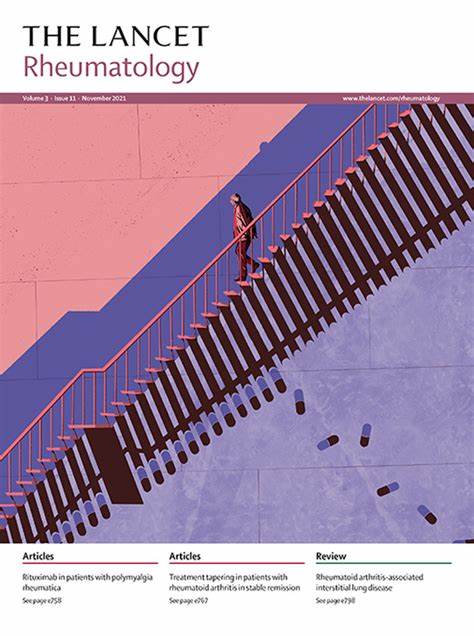Comparison of findings on contrast-enhanced MRI of the hand, wrist, and forefoot in healthy controls, two at-risk groups, and patients with rheumatoid arthritis: a cohort study
IF 16.4
1区 医学
Q1 RHEUMATOLOGY
引用次数: 0
Abstract
Background
The sensitivity of MRI in detecting joint inflammation in rheumatoid arthritis is well known but its specificity is less discussed. It is important to prevent false positive results and consequent overdiagnosis. Therefore, we aimed to examine MRI-detected inflammation that is less specific for rheumatoid arthritis by evaluating the frequencies of inflammation in healthy controls and in two at-risk groups who have not developed rheumatoid arthritis, compared with patients with rheumatoid arthritis.
Methods
In this cohort study, we performed contrast-enhanced MRIs of the second to fifth metacarpophalangeal, wrist, and first to fifth metatarsophalangeal joints of two at-risk groups (individuals with clinically suspect arthralgia and patients with undifferentiated arthritis who have not developed rheumatoid arthritis within a 2-year and 1-year follow-up period, respectively), and patients with rheumatoid arthritis, from two longitudinal observational cohort studies at Leiden University Medical Centre, Netherlands; the Leiden Early Arthritis Clinic (EAC) and the clinically suspect arthralgia (CSA) cohort. Healthy volunteers were also recruited as controls from Leiden University Medical Centre. MRIs were evaluated for synovitis, tenosynovitis, and osteitis using the Rheumatoid Arthritis MRI Scoring system. Intermetatarsal bursitis was also evaluated. All MRIs were scored by two readers independently of each other and who were blinded for clinical data. Each site was graded 0 (no inflammation), 1 (low), 2 (moderate), or 3 (severe). Increased signal intensity of joints, tendon sheaths, and bones were considered as less specific for rheumatoid arthritis if a similar signal intensity grade was present in more than 5% of the reference group. Comparisons were made in the following age-strata: <40 years, 40–59 years, and ≥60 years. Patient partners were involved in the design of the EAC and CSA cohorts.
Findings
Participants with valid MRI data from the EAC cohort (enrolled Aug 24, 2010, to March 9, 2020]) and the CSA cohort (enrolled April 3, 2012, to April 29, 2021), and 193 healthy volunteers (enrolled between Nov 15, 2013, to Dec 2, 2014) were included. At follow-up, 516 patients had rheumatoid arthritis, 305 had undifferentiated arthritis, and 598 had clinically suspect arthralgia. Of all participants, 1089 (68%) of 1612 were female and 523 (32%) were male, 1105 (94%) of 1160 were White, and mean age was 51 years (SD 14). Grade 2 and 3 synovitis, tenosynovitis, or osteitis did not occur in more than 5% of healthy controls and clinically suspect arthralgia non-converters (of all ages), therefore grade 1 inflammation in these reference populations versus patients with rheumatoid arthritis was evaluated. Grade 1 inflammation was found at a number of sites in the hand, wrist, and forefoot in more than 5% in all reference populations across all age groups, and these locations of inflammation were also frequently seen in patients with rheumatoid arthritis. The frequency of inflammation across all cohorts increased with age. Grade 2 inflammation that occurred in more than 5% was only present in patients with non-progressing undifferentiated arthritis aged 60 years or older.
Interpretation
We describe several low-grade MRI-detected inflammatory findings of the hand, wrist, and forefoot that are less specific for rheumatoid arthritis. These include locations that are regularly inflamed in rheumatoid arthritis. These findings could assist in avoiding overinterpretation when using contrast-enhanced MRI.
Funding
Dutch Arthritis Foundation.
健康对照者、两个危险组和类风湿关节炎患者的手、手腕和前足对比增强MRI检查结果的比较:一项队列研究
背景:MRI检测类风湿关节炎关节炎症的敏感性是众所周知的,但其特异性讨论较少。重要的是要防止假阳性结果和随之而来的过度诊断。因此,我们的目的是通过评估健康对照组和两个未发生类风湿关节炎的高危组中与类风湿关节炎患者相比的炎症频率,来检查mri检测到的类风湿关节炎特异性较低的炎症。方法:在这项队列研究中,我们对两个高危组(临床疑似关节痛患者和未分化关节炎患者,分别在2年和1年随访期内未发生类风湿关节炎)和类风湿关节炎患者的第二至第五跖指关节、腕关节和第一至第五跖指关节进行了对比增强mri检查。来自荷兰莱顿大学医学中心的两项纵向观察队列研究;莱顿早期关节炎诊所(EAC)和临床疑似关节痛(CSA)队列。还从莱顿大学医学中心招募了健康志愿者作为对照。使用类风湿关节炎MRI评分系统评估滑膜炎、腱鞘炎和骨炎的MRI表现。跖骨间滑囊炎也被评估。所有的核磁共振成像都是由两名独立的读者评分的,他们的临床数据是盲法的。每个部位分为0(无炎症)、1(低)、2(中度)或3(严重)。关节、肌腱鞘和骨骼的信号强度增加,如果超过5%的参照组存在类似的信号强度等级,则认为类风湿关节炎的特异性较低。研究结果:EAC队列(2010年8月24日至2020年3月9日)和CSA队列(2012年4月3日至2021年4月29日)中具有有效MRI数据的参与者,以及193名健康志愿者(2013年11月15日至2014年12月2日)。在随访中,516例患者患有类风湿关节炎,305例患有未分化关节炎,598例临床疑似关节痛。在所有参与者中,1612人中女性1089人(68%),男性523人(32%),1160人中白人1105人(94%),平均年龄51岁(SD 14)。2级和3级滑膜炎、腱鞘炎或骨炎未发生在超过5%的健康对照者和临床疑似关节痛非转换者(所有年龄)中,因此评估了这些参考人群与类风湿关节炎患者的1级炎症。在所有年龄组的所有参考人群中,在手、手腕和前足的许多部位发现了超过5%的1级炎症,这些炎症部位也常见于类风湿关节炎患者。在所有队列中,炎症的频率随着年龄的增长而增加。2级炎症发生率超过5%,仅出现在60岁或以上的无进展性未分化关节炎患者中。解释:我们描述了几个低级别mri检测到的手、手腕和前足炎症,这些炎症对类风湿关节炎的特异性较低。这些包括在类风湿关节炎中经常发炎的部位。这些发现有助于避免使用对比增强MRI时的过度解读。资助:荷兰关节炎基金会。
本文章由计算机程序翻译,如有差异,请以英文原文为准。
求助全文
约1分钟内获得全文
求助全文
来源期刊

Lancet Rheumatology
RHEUMATOLOGY-
CiteScore
34.70
自引率
3.10%
发文量
279
期刊介绍:
The Lancet Rheumatology, an independent journal, is dedicated to publishing content relevant to rheumatology specialists worldwide. It focuses on studies that advance clinical practice, challenge existing norms, and advocate for changes in health policy. The journal covers clinical research, particularly clinical trials, expert reviews, and thought-provoking commentary on the diagnosis, classification, management, and prevention of rheumatic diseases, including arthritis, musculoskeletal disorders, connective tissue diseases, and immune system disorders. Additionally, it publishes high-quality translational studies supported by robust clinical data, prioritizing those that identify potential new therapeutic targets, advance precision medicine efforts, or directly contribute to future clinical trials.
With its strong clinical orientation, The Lancet Rheumatology serves as an independent voice for the rheumatology community, advocating strongly for the enhancement of patients' lives affected by rheumatic diseases worldwide.
 求助内容:
求助内容: 应助结果提醒方式:
应助结果提醒方式:


